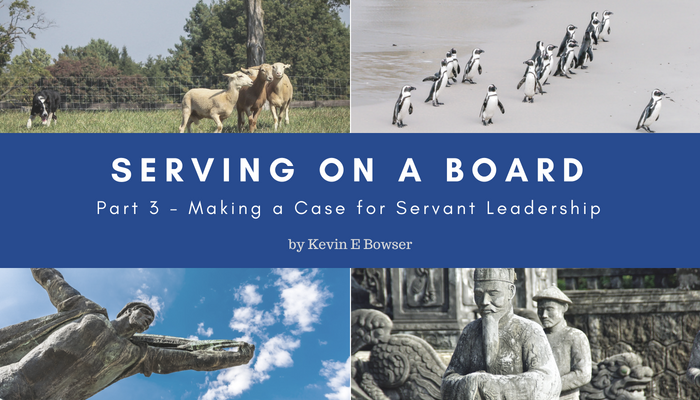Making a Case for Servant Leadership
We have covered the role of a body or group of leaders known as a board. And we have covered the role of the individual within that body. Now it is time for the secret sauce if there is such a thing. From my perspective, the secret sauce is servant leadership.
What is Servant Leadership?
While the idea of servant leadership goes back multiple millennia, the modern servant leadership movement was given voice by Robert K. Greenleaf in 1970 with the publication of his essay, The Servant as Leader. Greenleaf defined the servant-leader as follows:
“The servant-leader is servant first… It begins with the natural feeling that one wants to serve, to serve first. Then conscious choice brings one to aspire to lead. That person is sharply different from one who is leader first, perhaps because of the need to assuage an unusual power drive or to acquire material possessions. The leader-first and the servant-first are two extreme types. Between them there are shadings and blends that are part of the infinite variety of human nature.”
The more recent application of servant leadership to business and industry has taken the form of focusing on a set of behaviors and practices that turn the traditional “power leadership” model upside down. Rather than the followers working to serve the leader, the leader actually exists to serve the followers. Servant leadership is centered on a desire to serve and emphasizes collaboration, trust, empathy, and the ethical use of power. Its primary goal is to enhance individual growth, teamwork and overall organizational involvement and satisfaction.
Why Servant Leadership?
Although I have been focusing on non-profit boards, business and industry have been drawn to this leadership style because the end result (whether intentional or accidental) is a greater focus on the employee and the customer as the growth engine of the organization. This focus has resulted in increased engagement and “buy-in” from both internal and external stakeholders (employees, management, customers). Benefits accrue in both tangible and intangible ways.
How does this look on the board of a non-profit organization?
The overwhelming majority of non-profit organizations are lead by volunteer and unpaid individuals. The operational staff is often paid. But the board is rarely paid or provided any form of a stipend. So, it is a given that they are there to serve the organization. And, in a sense, the board is already set up to serve the operational team under this scenario.
But, let me hasten to say that just because we are often volunteers, that fact does not place us in a position of servitude. We are not indentured or slaves to the organization. We are, in fact, the leaders of the organization. We just execute that leadership with the heart of a servant.
Let’s get practical
How would servant leadership manifest itself in us? Perhaps it would show up in our leadership behaviors in the following ways:
Ethical Leadership — Servant leaders are ethical leaders. I toyed with the idea of using the words “moral leadership.” But, morality seems to be an emotional word. More folks are willing to accept the idea of ethical leadership. Largely because most people view morality on the individual choice level, while ethics are more easily viewed as having a societal impact. A servant leader recognizes that they are there to lead and to do so to bring maximum value to the organization and not themselves.
Empathetic Leadership — Servant leaders are empathetic leaders. They take the time to get to know those they lead and they know their pain points. And they seek to minimize that pain. They form real and long-term relationships with their followers and put their interests above their own. A servant leader recognizes that they are there to do no harm to those they lead.
Encouraging Leadership — Servant leaders are encouraging leaders. Here, I also toyed with another word. I thought about using the word enthusiastic because it embodies the emotion of encouragement. And I will admit it, there are sometimes when our role looks a lot like that of a cheerleader for the staff or for the organization. They are there to give those words that promote the individual and corporate actions of the staff and team. A servant leader recognizes that their words have an impact and chooses those words carefully.
Thank you
I know that many of you are in various leadership roles. So, I say “Thank you!” You are not in it for the money. You are a volunteer! And you are not in it for the recognition. You often labor in anonymity. And you don’t do it for gratitude that is expressed by the organization. You have an internal sense of gratitude for having served and having done the best that you can.
But, I say a big “Thank YOU!” for being willing to serve on a board and to lead with servant leadership.
I am the husband of a beautiful and wonderful woman. I am the father of two of the greatest kids on the planet. I am a father-in-law to a great young woman. And I am Papa to three very special grandchildren. In my spare time I am an active blogger and writer. And if there is any time left over, I work with small non-profit organizations and churches on the topics of change management, crisis intervention and leadership development.


Recent Comments